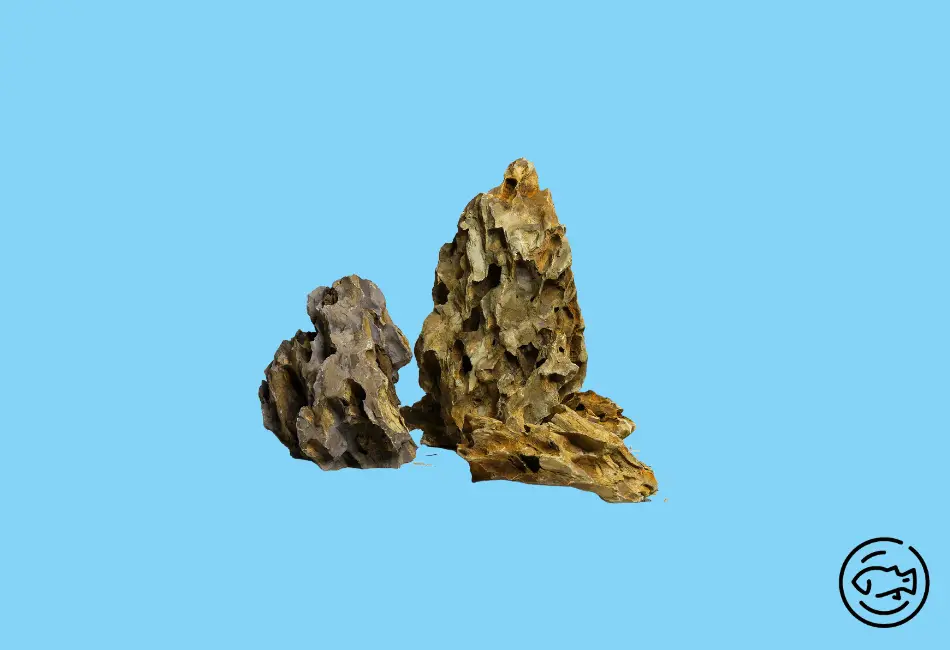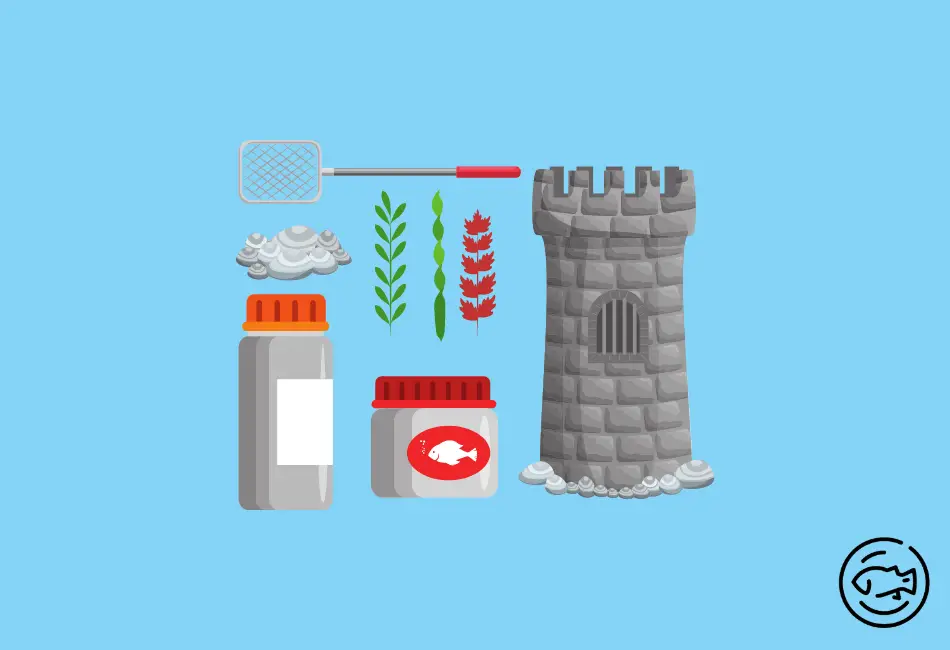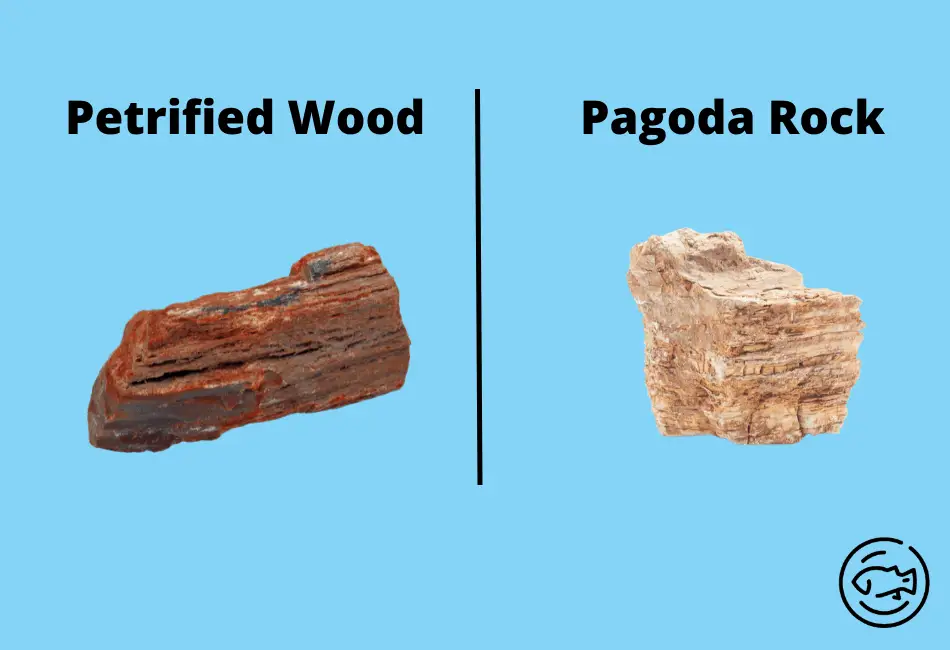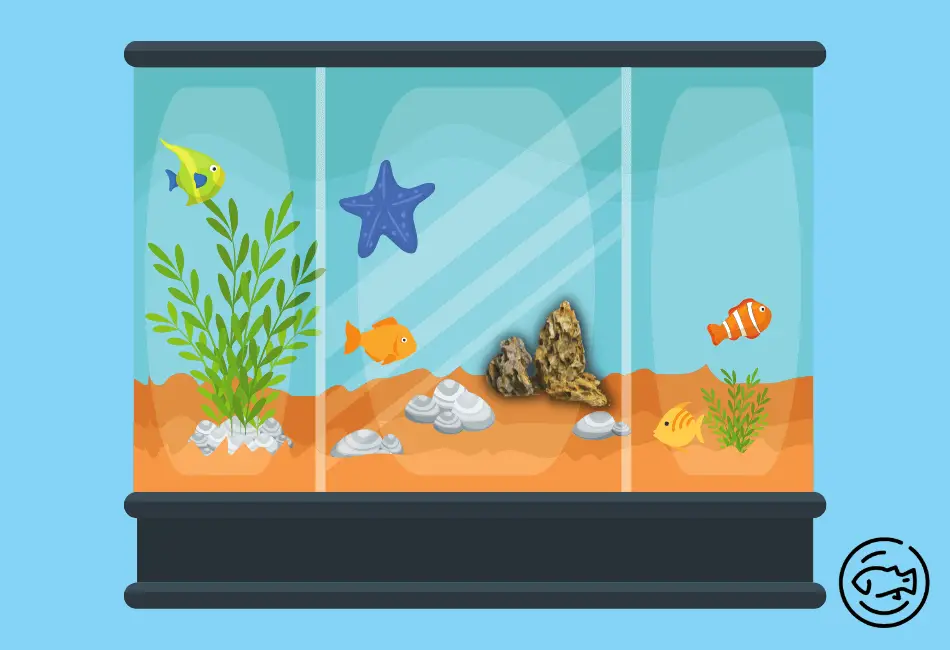The most intriguing aspect of Dragon Stone in the Aquarium is its appearance. Ohko means “scales,” which perfectly reflects this unique texture!
It can be used in just about any tank setup and helps support a thriving ecosystem within your home aquarium!
What is a Dragon Stone?
Dragon stone’s beautiful, natural look is only enhanced by its all-natural sedimentary rock origins. Dragon Stone is also known as Ohko Stone.
Dragon stones come from clastic sedimentary rock comprised of silt & clay minerals packed together under high-pressure waves in an earthy substance known as diatomaceous earth.
These fantastic rocks can be found worldwide with varying appearances depending on where they’re harvested – but no matter what form it takes, there’ll always be something captivating about this ancient gravel!
What Does Dragon Stone Look Like?

The Dragon Stone has a unique, scaly appearance that resembles a dragon’s skin. The exterior possesses numerous natural cavities, small crevices, and gaps of varying depths.
It can be found in many different colors and textures but often looks similar enough to petrified wood or driftwood, so it’s an excellent aesthetic choice for tank owners who want their tanks to look natural!
As high-pressure waves beat against the stone, they drive sediments into soft sections that cause small holes and divots in young dragon rocks.
The particulate matter chips away and penetrates deep down to leave rough marks around the stone.
The waves are constantly crashing against the hard surfaces of rock, but some areas hold firm and don’t give in. These places can be found on dragon-shaped sea stacks where they form due to pressure from tides packing sediment onto these extremely sharp surfaces.
The sun’s warmth slowly cooks the pile of clay and microorganisms on top. It takes time for this to harden, but once it does, you’ll get a beautiful dragon stone with unique coloration that is unique!
The beautiful colors of dragon stone result from the varying hues it can take depending on where in its journey through nature’s landfills this rock has been exposed to.
It may be brown or olive green, but the appearance of a dragon stone can vary depending on where it is from.
Some have red, yellow, or orange hues to them, and this is because the inert rock absorbs color from its surroundings.
Where are Dragon Stones Found?

The traditional dragon stones aquarium comes from Japan’s lakes, ponds, and oceans.
The rough waters and ample sediment make for an ideal hotspot for dragon stone growth.
Japanese dragon stone is a rare and valuable commodity, but luckily there are alternatives out in the market.
Today’s aquarium owners can find imported duplicates of Ohko stones from Japan at their local pet stores.
Various locations around the world produce dragon stones for home aquariums. These include Utah in America, Canada, and England, making them just as safe to use but often less expensive than the dragon rocks from Japan.
The beautiful colors of these stones are what make them so unique. They come from places all over Ohko, but you can usually identify which region a dragon stone comes from just by looking at it!
These stones often display more vibrant colors such as reds, yellows, and oranges instead of a mossy brown or green color.
Favorable Environment for Dragon Stone

The Dragon’s stone is a powerful force that holds up well in most freshwater aquariums, but it tends to fare best when kept in similar environments or water parameters just like its natural habitat.
It’s no surprise that this type of rock prefers slightly acidic water with a neutral pH of around six or seven.
The acid in an acidic tank environment will slow the degradation of each dragon rock, meaning that you’ll have longer-lasting landscape features.
What is Dragon Stone For Aquarium?

Having a hardscape in your tank setup is suitable for aesthetics and provides many benefits.
Dragon Stone is one of the best choices to use when building the groundwaters around plants and stones.
Hardscapes are the perfect setting for building an underwater ecosystem. They provide a healthy foundation by adding ideal layout material such as rock & wood that can be decorated with anchoring plants in their new home!
Providing your tank inhabitants with plenty of spots to explore, hide and relax is another crucial point in creating a creative hardscape setup.
One of the essential things for fish is to have plenty of natural stimulation in their environment. This can be difficult when you’re dealing with shy or otherwise sensitive types such as bettas, but it’s easy enough if they have something like a rocky hardscape explicitly designed around them!
Benefits of Dragon Stone For Aquarium

The rough, scaly texture of dragon stone is not only attractive but can make a valuable addition to your growing aquascape.
The dragon stone is an excellent surface for plant roots to grow on and anchor themselves in. The rock’s natural pores offer plenty of space where plants can pick up nutrients as they filter water through the Dragon stone.
This stone’s many nooks and crannies deliver safety for critters of all shapes & sizes.
The porous nature of this stone allows water to pass through it easily, which makes for an easy escape route if your fish gets trapped on one side. It also allows small animals like snails or shrimp to settle in its cracks.
Its lightweight construction also means that you’ll be able to move it around with less effort when carrying multiple stones.
The aquarium dragon stone is the perfect rock for those who want to keep their fish safe. It’s less likely than other heavier alternatives like granite or sandstone, so there’s no need to worry about any toppling sculptures endangering your aquatic friends!
The lightweight stone is ideal for making large or tall hardscapes in your aquarium without any problems.
This material is an inert, non-toxic substance that won’t affect the pH level of your tank water. It also doesn’t shed into its surrounding environment and can be easily replaced when needed.
The hardiness of dragon rock makes it an excellent choice for freshwater setups as it is safe to use even with pH–sensitive plants and fish.
You have to remove debris to keep your aquarium clean, that may accumulate on the surface of dragon stone.
The pH level of your tank cannot be affected by the dragon rock itself, but it’s essential to clean the dragon stone regularly to maintain tank health. This will help avoid imbalances of nutrients, which can lead over time, if left unchecked, and can cause significant issues for your aquatic inhabitants.
Risks of Adding Dragon Stone to Aquarium

It’s essential to make sure the stone in your aquarium is clean and securely attached before adding it.
Dragonstone is a fragile stone that cannot withstand harsh treatment. The porous nature of this material makes it easy to break and brittle, so be careful with your aquarium decor!
Dropping or even rough cleaning can break dragon stone and cause chipping. To avoid any damage, it’s important to use hand & eye protection when handling these stones- especially when cleaning.
High-pressure water flows may also cause breakage in dragon stone compositions, which will deteriorate carefully created hardscapes over time!
The stone’s rough surface is prone to accumulating dirt, algae, and other matter.
To keep the aquarium healthy, it’s essential to clean the dragon stone regularly. Otherwise, trapped debris may alter water chemistry and damage inhabitants!
Those who choose to include a dragon stone in their setup should plan for careful, long-term maintenance as it can easily change the water chemistry of your aquascape.
How To Prepare Dragon Stone for the Aquarium

The addition of dragon stone to your aquarium setup is an exciting time. However, before adding it be sure that you have thoroughly cleaned the rock and any inhabitants to make life easy for yourself and them.
The tank’s water can become unsafe if you have an unclean or poorly cleaned dragon stone in your possession. These stones are known for leeching dangerous compounds into the surrounding environment, potentially changing the chemical composition, pH levels, and even the color of the water.
To get the most out of your new dragon stone, start by rinsing it thoroughly in a bucket filled with cold water. Then apply medium pressure water only to clean all cracks and pores without damaging this delicate mineral.
A soft toothpick is a perfect tool for getting into those tight spaces when removing lodged or trapped materials.
A wooden skewer will also work well to dislodge any entangled materials in the Dragon Stone.
Until the water runs clear of harmful compounds or sediment, keep rinsing each stone.
Before adding the rocks to your aquarium, make sure they’re clean and dry. Then you can add them to the tank without any problems.
How To Care for Dragon Stone

To keep your tank safe and its residents comfortable, you need to maintain and take care of Dragon stones regularly.
Cleaning your tank can be a tedious task, but it’s worth the effort. Remove each rock and rinse with cold water on medium pressure to clean effectively.
It is essential to use a soft brush or skewer when removing stubborn debris.
The best way to keep your dragon stones looking amazing is by using a natural cleaner. Avoid chemical cleaners, as they can soak into the porous clay and harm inhabitants in an aquarium later on when you’re unsure if it’s safe for fish.
Dragon Stone Sculptures
These Dragon stone sculptures not only look amazing, but they can also bring some plant life to your tank.
The variety of aquascapes is wide and ever-changing, with some incorporating large unbroken rocks while others prefer to customize the look.
You can efficiently break apart the Dragon stone into smaller broken pieces to create different structures, such as towers and arches.
If you’re looking for an easy way to break up larger pieces of dragon stone into smaller pieces, then hitting it with a mallet or hammer might be your best bet. However – this could destroy some expensive stones.
Chisels offer a greater degree of control when shaping dragon stones. This allows you to work precisely and achieve precisely what your setup requires, be it small details or larger scale designs.
Owners of aquariums with a dragon stone floor may choose not to pay much attention to their setup. Instead, they provide plants and other decorations on top for the natural rock to shine through more brilliantly than ever before.
Alternatives of Dragon Stone

Many hardscaping materials can be used in place of dragon stone.
Petrified wood is an excellent stone for creating its own unique designs and patterns.
A variety of colors can be found on this material, making it perfect as an accent piece in your aquarium.
The gorgeous Pagoda Rock has a lot to offer! Along with all those nooks and crannies, it’s also bright with flashy colors like orange or red.
It is crucial to consider the consequences of adding any new decor to your tank, especially if it’s a natural material like stone.
Conclusion Dragon Stone
If you’re looking for an elegant and natural-looking way to decorate your freshwater aquarium, then dragon stone is just what you need!
This beautiful rock allows fish as well as plants a safe haven. They will thrive in their new surroundings while providing beauty inside your aquarium with proper care.
These bring visual appeal, but they also provide great functionality by helping enhance oxygenation within tanks.



